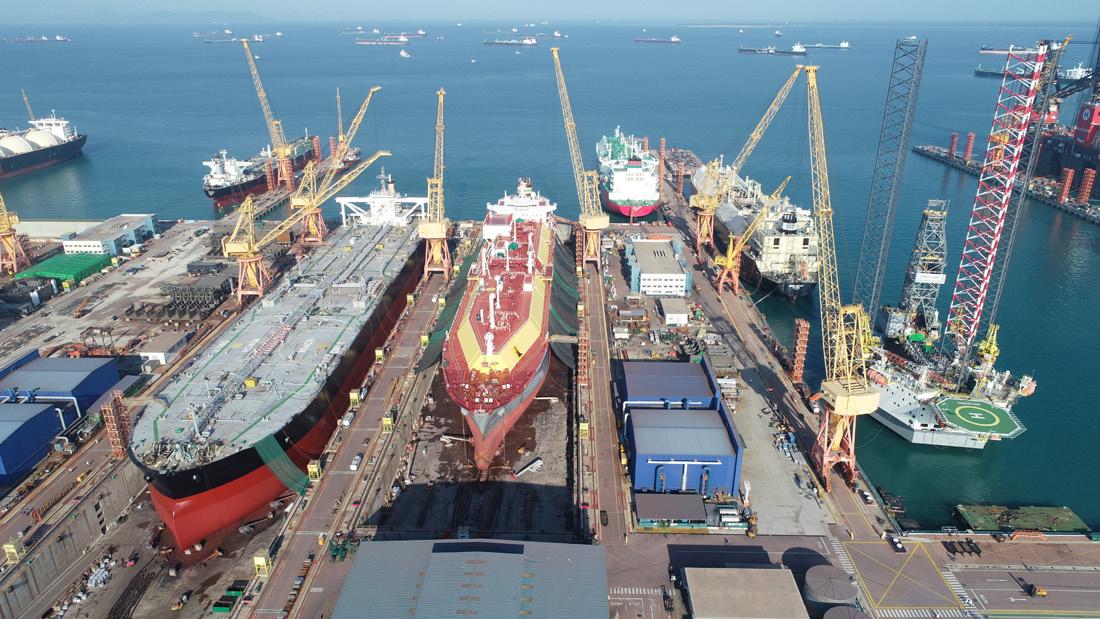LNG New retrofit solution from Newport Shipping Germany’s Marine Service and Newport Shipping have announced an AiP from Bureau Veritas (BV) for a jointly developed containerised LNG solution. The 40’ ISO LNG Fuel Tank Container System is suitable for LNG-fuelled newbuildings and retrofits of containerships. The LNG fuel tank container is a class approved Type C LNG fuel tank in accordance with the IGF-code and is based on German TÜV certified IMDG Container. The capacity of the tank is 31 gt (about 33 m3 of LNG). The containers have a fail-safe dry quick coupling connection and are approved for loading in up to seven layers high stacks. The stainless-steel double-walled tank is also vacuum insulated and has up to 80 days holding time. The concept comprises container stowage on free deck in safe area, all the containers located above deck. According to Newport Shipping, “There will be no loss of container capacity when installing this system.” LNG piping and venting system as well as fire-fighting systems are integrated in the container cell guides structure. The gas handling room is arranged adjacent to the container storage and separated from the containers by a cofferdam and fire protection means, allowing to feed low pressure and high-pressure fuel gas systems for all known 4-stroke and 2-stroke dual fuel engines. A full redundant control, alarm & monitoring system for remote system operation, gas and fire alarm with interface to ships’ automation is part of the system. Since LNG containers are portable, the total number of containers can be easily optimised according to the owners’ requirements. Simple and easy to install on-board, when a ship is in port, the empty containers can be taken out and replaced by new filled ones. It may be normal to install this concept during a drydocking, with no additional time for the drydocking involved. Ingmar Loges, Managing Director,
The Newport Shipping concept for LNG-fuelled containerships
The conversion of the containership Sajir was carried out in China’s Huarun Dadong Dockyard
Newport Shipping says, “The global shipping industry faces unprecedented challenges as environmental regulations tighten. The shipping industry needs alternatives. The containerised LNG concept provides an answer to these challenges.” Marine Service develops several LNG fuel solutions including tank containers. The containers are an alternative solution to traditional LNG bunkering. Newport Shipping offers its customers full retrofit services for Marine Service’s LNG fuel tank container solutions at its 15 yards that it works in co-operation with. With flexible financing options and a quick delivery of turnkey LNG retrofit options the company expects that this will present itself an attractive option for clients in the near future. “We are glad to have reached an Approval in Principle from BV for our containerised LNG as fuel solution. LNG is one of the most promising alternative fuels by now,” says Christian Krämer, Chairman of Marine Service. Meanwhile, SEA-LNG has announced the membership of Newport Shipping. The addition of Newport Shipping strengthens the operational skill base of SEA-LNG’s membership across the LNG marine fuel value chain. It also highlights the breadth of engaged stakeholders in the LNG market, who are collaborating to achieve a cleaner and greener shipping sector, thereby helping the industry meet the environmental, commercial and operational challenges of the 21st Century.
Page 40 – www.shipandoffshorerepair.com
AiP from BV for GTT’s retrofitting concept During a recent ceremony at France’s Bureau Veritas (BV), GTT, Alwena Shipping, a naval consultancy and engineering firm, and China’s COSCO Shipping Heavy Industry (Zhoushan) shipyard, have received an AiP from BV for a new concept, combining LNG retrofit and jumboisation, applied to large containerships. GTT carried out the LNG Mark III membrane tank design while its integration into the ship was designed and validated by Alwena Shipping. CHI Zhoushan shipyard validated the operational aspects of the project, including the work sequence, planning and workforce resources. The length increase of the ship (or jumboisation), combined with the LNG conversion of the propulsion and electrical generation systems enables a reduction in the operating costs of the ship, which limits the financial impact of the immobilisation period required for the retrofit operation. LNG propulsion offers ship-owners a solution to comply with the environmental regulations being adopted by IMO by 2045. In comparison with a conventional fuel-powered container ship, the converted vessel reduces CO2 emissions by around 23% over an 83-day Europe-Asia return trip (port calls included). The work carried out within the Joint Development Program (JDP) between GTT,












